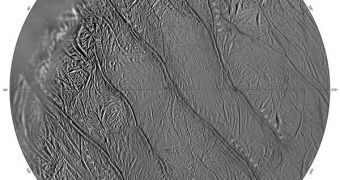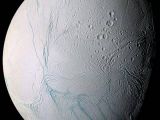Saturn's moon Enceladus is, in many aspects, one of the most peculiar celestial bodies in the solar system. Once regarded as nothing more than a ball of frozen ice and dust, it revealed itself in 2006 to be still active, and potentially even harboring liquid water underneath the surface. Additionally, its weird features, including “tiger stripes” across its surface, have had astronomers and physicists wondering what its internal structure looks like. A new study by an Australian astronomer offers a possible explanation for these peculiar structures, to be published in the August issue of the planetary science journal Icarus.
According to University of Melbourne School of Earth Sciences Centenary Research Fellow Dr. Dave Stegman, the stripe-like features on the planet are generated not by an internal, hot core, such as previously held, but by the body's own internal chemical composition. The find could help further research fields such as planetary development and may even help space agencies develop new guidelines on space exploration for future missions.
“NASA's Cassini spacecraft recently revealed Enceladus as a dynamic place, recording geological features such as geysers emerging from the 'tiger stripes' which are thought to be cracks caused by tectonic activity on the south pole of the moon's surface,” Dr. Stegman says. When the space probe passed by the moon in 2006, it observed a tall plume of water vapors coming out of its surface, hinting at forces within that were still capable of causing an eruption.
Together with his team, the researcher was amazed at the fact that such a small moon, which is smaller than the UK in size, was able to exhibit volcanic activity while being completely covered in ice. In fact, it's this very trait that makes it one of the most luminous objects in the sky. It reflects just under 100 percent of the sunlight hitting it, and has an estimated surface temperature of -201°Celsius (-330°F). Amazed by these traits, the team set out to virtually explore Enceladus, using very complex computer simulations for the job.
“We found that if a layer of pure water ice formed near the core, it would have enough buoyancy to rise upwards, and such a redistribution of mass can generate large tectonic stresses at the surface. However, the pure water ice rising up is also slightly warmer which causes the separation to occur again, this time forming an ammonia-enriched ocean just under the surface,” the team reveals.
“The presence of ammonia, which acts as an anti-freeze, then helps keep the ocean in its liquid state. These simulations are an important step in understanding how planets evolve and provide questions to focus future space exploration and observations. It will hopefully progress our understanding of how and why planets and moons are different to each other,” Dr. Stegman says.

 14 DAY TRIAL //
14 DAY TRIAL // 
